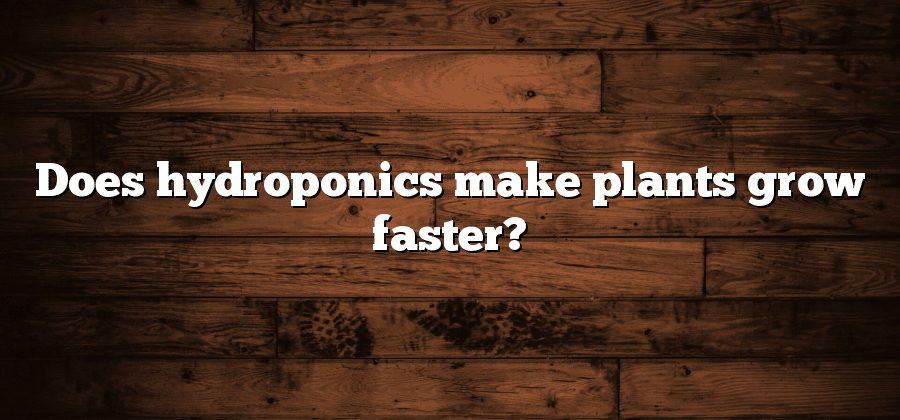Understanding Hydroponics: An Overview of the Technique
Hydroponics is a revolutionary technique that has gained significant attention in recent years. This method of growing plants without soil offers numerous advantages over traditional agriculture practices. By providing a controlled environment and maximizing nutrient availability, hydroponics allows for faster and more efficient plant growth.
In hydroponics, plants are grown in a nutrient-rich solution that is carefully monitored to ensure the optimum balance of essential elements. This technique eliminates the need for soil, making it possible to grow plants in any location, regardless of soil quality. By directly providing nutrients to the plants’ roots, hydroponics eliminates the risk of nutrient deficiencies or imbalances, ensuring vigorous and healthy growth. Additionally, the controlled environment of hydroponic systems minimizes the risk of pests and diseases, leading to higher yields and reduced crop losses.
Enhancing Nutrient Availability: How Hydroponics Optimizes Plant Growth
In hydroponics, the optimization of plant growth begins with enhancing nutrient availability. Unlike traditional soil-based methods, hydroponics allows for precise and controlled delivery of nutrients directly to plant roots. This targeted approach ensures that plants receive the necessary balance of macronutrients, micronutrients, and trace elements required for growth and development.
By eliminating the need for plants to extract nutrients from the soil, hydroponics maximizes the efficiency of nutrient uptake. This is particularly beneficial in environments where soil quality may be poor or depleted. With hydroponics, growers have the ability to monitor and adjust nutrient levels in real-time, ensuring plants receive the optimal balance of nutrients at each stage of growth. This precise control over nutrient availability promotes stronger root development, faster plant growth, and ultimately, higher crop yields.
Additionally, hydroponics systems can be designed to recycle and reuse nutrient solutions, further enhancing nutrient availability. By regularly monitoring and managing the nutrient solution, growers can prevent nutrient imbalances and deficiencies. This not only reduces waste and conserves resources, but it also minimizes the reliance on external inputs, making hydroponics a sustainable and efficient method for optimizing nutrient availability and maximizing plant growth.
The Impact of Oxygenation: Why Hydroponics Supports Faster Growth
Hydroponics, as a soilless cultivation method, has gained significant attention in the agriculture industry. The impact of oxygenation in hydroponics is essential in promoting faster plant growth. Unlike traditional soil-based farming, hydroponics provides plants with a highly oxygenated environment, ensuring optimum oxygen availability for their root systems.
Oxygen plays a vital role in a plant’s overall growth and development. It is crucial for the respiration of plant cells, allowing them to convert nutrients into usable energy. In a hydroponic system, the roots are directly exposed to oxygen-rich solutions, increasing the efficiency of nutrient absorption. This oxygenation enables plants to absorb nutrients more rapidly, resulting in accelerated growth rates. Additionally, the ample oxygen supply inhibits the growth of harmful anaerobic organisms while promoting the growth of beneficial aerobic bacteria that contribute to healthy root systems.
Efficient Water Management: A Key Factor in Accelerated Plant Growth
When it comes to hydroponics, one of the key factors that contribute to accelerated plant growth is efficient water management. Unlike traditional soil-based cultivation, hydroponic systems use a closed-loop system that recirculates water and nutrients, minimizing waste significantly. This allows plants to have constant access to the necessary elements for growth, without the risk of over or under watering.
In hydroponics, water is carefully monitored and regulated to ensure that plants receive the proper amount of moisture and nutrients at all times. The use of sensors and automated systems enable precise control over water levels, pH levels, and nutrient concentration, maximizing the plants’ growth potential. Furthermore, the recirculation of water within the system reduces the overall water consumption, making hydroponics a more water-efficient alternative to traditional farming methods.
Efficient water management plays a crucial role in promoting accelerated plant growth in hydroponics. By providing plants with a constant supply of water and nutrients, in carefully controlled amounts, hydroponic systems optimize the growing conditions and eliminate the limitations imposed by soil-based cultivation. As a result, hydroponic plants are able to grow faster and healthier, ultimately leading to increased productivity and yield.
Minimizing Pest and Disease Risks: How Hydroponics Promotes Healthy Plants
Hydroponics, the innovative method of growing plants without soil, offers numerous advantages when it comes to minimizing pest and disease risks and promoting healthy plants. One of the key factors contributing to this is the controlled environment that hydroponics provides. By eliminating soil, which can harbor pests and diseases, hydroponic systems help reduce the entry and spread of harmful organisms. This controlled environment also allows growers to closely monitor and regulate factors such as temperature, humidity, and lighting, further minimizing the risk of pests and diseases.
Additionally, the use of sterile growing media in hydroponics helps prevent the introduction of pathogens that can cause diseases in plants. The absence of soil-borne pathogens in hydroponic systems means that plants are less susceptible to infections, leading to healthier overall growth. Furthermore, the closed-loop system of hydroponics, with its recirculating water and nutrient solution, reduces the chances of contamination from external sources, further safeguarding plants against potential diseases.






